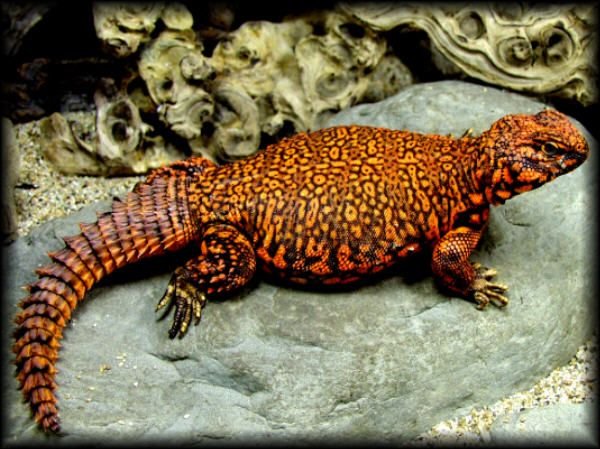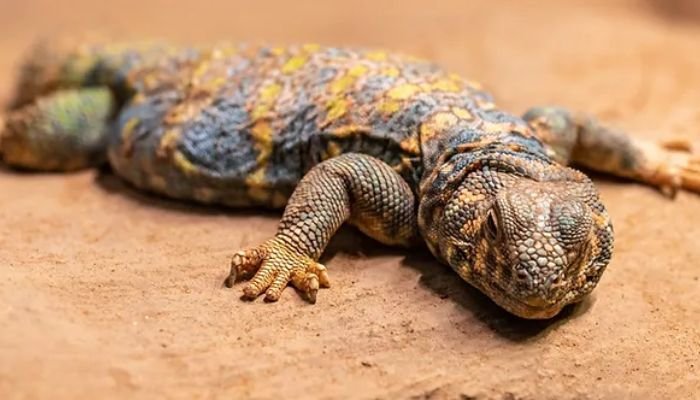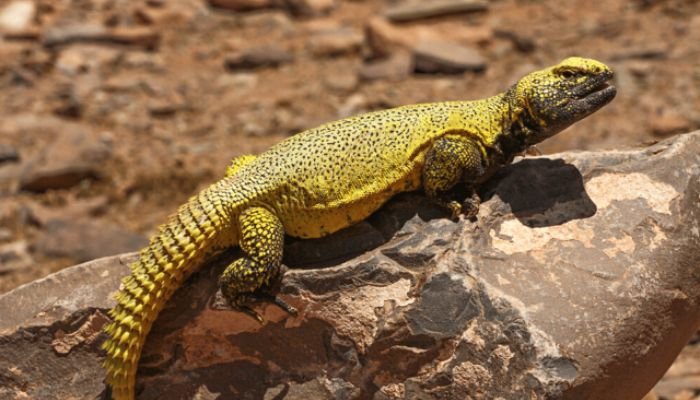
The Uromastyx, commonly known as the Spiny-tailed Lizard, is a diverse genus of reptiles native to arid regions of Africa, the Middle East, and Central Asia. They have successfully adapted to arid conditions, as evidenced by their robust bodies and spine-like tails. Herbivorous uromastyx reptiles consume specialized plant material and flora. They can survive in harsh environments due to their ability to ingest and retain water from their food.. Here are Uromastyx Guide on Food, Habitat, Size, Lifespan & Predators below-
Uromastyx Stats in Table format
The stats are given below for Uromastyx
| Reptiles List | Uromastyx |
|---|---|
| Family | Agamidae |
| Type | Lizard |
| Size | Small to Medium |
| Length | Uromastyx: Up to 10-18 inches (25-45 cm) |
| Color | Uromastyx: The color varies depending on the species, but uromastyx lizards can have shades of brown, orange, or yellow with patterns or markings. |
| Weight | Uromastyx: The weight varies depending on the species, but most uromastyx lizards can weigh between a few ounces to a pound or more.. |
| Lifespan | 10-20 years (or more) |
| Reproduction | Oviparous, lays eggs |
| Gestation Periods | The gestation period for Uromastyx is approximately 60-70 days. |
| Endangered Status | Least Concern (IUCN Red List) |
| Features | Stout body, spiky appearance |
| Country & Areas | Uromastyx is found in various countries and areas including North Africa, the Middle East, and parts of Asia. |
Uromastyx Natural Habitat and Distribution
Uromastyx are a family of diurnal reptiles of the genus Agamidae, usually known as spiny-tailed lizards. The dry and semiarid parts of Africa, the Middle East, and South Asia are their natural habitat. These intriguing animals have evolved specific adaptations that allow them to thrive in the arid conditions of the desert, where temperatures can soar and water is in short supply.
Uromastyx live in dry, arid environments like deserts and sand dunes. Burrowing is a common survival strategy for these animals, therefore they tend to congregate in sandy areas. Uromastyx enjoy environments with many of places to hide, such as rocky locations with cracks.
Uromastyx Physical Features and Adaptations
Here are some information about Uromastyx Physical Features and Adaptations
1. Body Structure
Uromastyx have a thick and stocky build. Their huge, muscular heads feature a rounded nose. Their short, powerful legs are armed with sharp claws that help them navigate the desert in search of food and shelter. Spiny scales protect and cool the animal by acting as a defense mechanism on the tail.
2. Coloration and Patterns
The color and pattern of uromastyx varies from species to species and from person to individual. Their bright yellows, oranges, reds, and browns complement the surrounding desert environment. The coloring could also aid in thermoregulation, as darker tones would soak up more morning chill and lighter tones would reflect afternoon sun.
3. Defense Mechanisms
Uromastyx have developed a variety of defense measures to ward off potential predators. Their strong, scale-covered tail serves as their first line of defense, and it can be used to whip or strike any attacker. They can also expand themselves to look bigger and scarier to potential predators if they feel threatened. They may rapidly and easily retreat underground because of their burrowing nature.
Uromastyx Diet and Feeding Habits
Here are some information about Uromastyx
1. Diet Type
Uromastyx are classified as herbivores, indicating that plants make up the bulk of their diet. Leaves, flowers, fruits, and seeds make up the bulk of their food. A digestive system adaptation makes it possible for them to get the most nutrition out of the rough, fibrous plants that grow in the desert.
2. Preferred Food Sources
Uromastyx prefer thistles, grasses, wild herbs, and succulents, all of which may be found in the desert where they are found in their natural habitat. In order to meet their nutritional needs while in captivity, it is crucial to offer a varied and well-balanced diet.
3. Feeding Schedule
Uromastyx are diurnal, or active primarily during daylight hours, reptiles. To best resemble their natural feeding schedule while in captivity, meals should be offered in the morning and early afternoon. It’s also important to have access to clean water constantly.
Uromastyx Housing and Enclosure Requirements
Here are some information about Uromastyx
1. Terrarium Size and Setup
The species and size of the individual uromastyx will determine the size and layout of the terrarium. The minimum recommended dimensions for a terrarium housing a small to medium sized uromastyx are 3 feet in length, 2 feet in width, and 2 feet in height. It’s possible that larger animals need more room. The cage needs branches, rocks, and hiding spots to make it feel more like their natural environment.
2. Substrate Options
Uromastyx must have a substrate that supports their innate digging habit. You can use sand, a sand-clay mixture, or soil that is safe for reptiles. They need to be able to burrow comfortably into the substrate.

3. Temperature and Lighting
Uromastyx require a temperature gradient in their habitat, as well as bright, indirect light. Both the warmer (100–120°F/37–49°C) and cooler (80–90°F/27–32°C) areas should be comfortable for the occupants. Heat and the necessary UVB radiation for calcium metabolism can be provided by a heat lamp and a UVB lamp, respectively.
4. Humidity and Water Needs
Uromastyx are able to survive in low humidity because they have adapted to life in the desert. However, a shallow water dish for drinking, soaking, and general hydration needs to be available.
Uromastyx Behaviour and Temperament
Here are some information about Uromastyx Behaviour and Temperament
1. Activity Levels
Uromastyx are primarily active during the day, when they may take advantage of the sun’s warmth to maintain a comfortable internal temperature. They are skilled climbers, so you can frequently find them perched on rocks or other lofty perches.
2. Social Behaviour
Uromastyx are not social animals; in fact, they prefer to be left alone. In the wild, they probably wouldn’t meet up until mating season.
3. Handling and Taming
While certain uromastyx may be tolerant of being handled, in general, these reptiles are not known for being friendly or cuddly pets. Overhandling can cause tension, therefore it’s best to avoid it if at all possible.
Uromastyx Breeding and Reproduction
Here are some information about Uromastyx Breeding and Reproduction
1. Mating and Courtship Rituals
Breeding in uromastyx typically takes place during the warmer months when conditions are optimal for mating and courtship rituals. Courtship displays, including as head bobbing, tail flicking, and colorful displays, are used by males to attract females.
2. Incubation and Hatchlings
After a successful mating, the female will construct a shallow nest or burrow in the sand and place her eggs inside. The eggs are subsequently exposed to the sun’s heat to incubate on their own. Incubation can last anywhere from a few weeks to a few months, depending on the species. The chicks are on their own once they emerge from their eggs and must learn to survive in the wild.
Uromastyx Common Health Issues and Veterinary Care
Here are some information about Uromastyx Common Health Issues and Veterinary Care
1. Respiratory Infections
Uromastyx are susceptible to respiratory illnesses if the humidity in their cage is too high, or if they are maintained in drafty or chilly circumstances. Difficulty breathing, nasal discharge, and fatigue are all symptoms of a respiratory illness.
2. Parasites
External and internal parasites pose a risk to the uromastyx. Parasite infestations can be controlled with routine fecal tests and prophylactic medication.
3. Metabolic Bone Disease
Weakened bones and uromastyx abnormalities are the results of metabolic bone disease, which can be brought on by a lack of UVB exposure and an inadequate calcium intake.

Importance of Regular Vet Check-ups
The health and well-being of a uromastyx depends on regular visits to the veterinarian. A trained reptile veterinarian may provide preventative care by doing thorough inspections, providing nutritional guidance, and spotting the first signs of illness.
Conclusion
Uromastyx are incredible reptiles because they have developed specialized physical traits that allow them to survive in the arid conditions of the desert. To ensure their health and happiness while in captivity, their enclosure, diet, and care needs should all be designed to reflect as closely as possible their original environment. Uromastyx can be intriguing and gratifying pets for those who take the time to care for them and take them to the vet on a regular basis. Keep in mind that appropriate knowledge and dedication are vital to giving the finest care possible for these remarkable creatures, as reptiles have specialized demands.
FAQs
Q: What is the family and Type of an Uromastyx?
Uromastyx is a genus of lizards in the family Agamidae.
Q: What is the average size of a Uromastyx?
The usual length of an Uromastyx is between 10 and 18 inches (25 and 45 cm), though this does vary from species to species.
Q: How long can a Uromastyx grow in size and length?
Uromastyx, depending on species, can continue growing throughout their lives and reach a maximum size and length of anywhere from 10 to 30 inches (25 to 76 cm) at maturity.
Q: What colors do Uromastyxs come in?
Uromastyx can be found in a wide spectrum of colors, from brown to yellow to orange to red. Species and individual variation can both affect the appearance of the animal.
Q: How big can a Uromastyx get in weight?
Uromastyx species vary in size and weight, although the average adult weighs anywhere from 200 to 600 grams (0.44 to 1.32 lb).
Q: How long do Uromastyxs live?
With the right care, a captive Uromastyx can survive for up to 25 years on average.
Q: How do Uromastyxs give birth?
Answer: A. Uromastyx are oviparous, which means they produce eggs. To reproduce, females typically excavate a hole in the ground and deposit their eggs there. The eggs will hatch after being incubated.
Q: How long is the gestation period for a Uromastyx?
Incubation of eggs, which can take anywhere from 45 to 90 days depending on the species and the conditions in which it was laid, is the gestation period for Uromastyx.
Q: Is the Uromastyx endangered?
Some species of Uromastyx are more endangered than others, hence their conservation status varies. Some species are more stable in the wild than others, while others are critically endangered.
Q: What are the prey of Uromastyxs?
Uromastyx, being herbivores, subsist mostly on plant matter, such as a wide variety of leaves, flowers, and vegetables. They don’t hunt for food but rather consume plant matter.
Q: Do Uromastyxs have any Predators?
Birds of prey, snakes, larger carnivorous animals, and other predatory reptiles are all potential threats to an Uromastyx in the wild.
Q: How Fast Does Uromastyxs Move?
Reptiles of the genus Uromastyx are not known for their speed. They are better suited for slow and steady sunbathing than quick sprints.
Q. What is Bite Force of Uromastyx in PSI?
As for your second question, the biting force of Uromastyx has not been examined or tested as thoroughly as that of larger carnivorous reptiles, but it is generally thought to be quite mild.
Q. Can we keep Uromastyxs as pets?
Uromastyx can be kept as pets, but only if you give them the attention they need. Their health depends on having an appropriate habitat with adequate food, illumination, and temperature.
Q. Are Uromastyxs good for pest control?
Uromastyx are not employed in pest management. Plants are their primary diet, hence they are ineffective as pest controllers.
Q. Do Uromastyxs require a UVB light source?
I hope you like reading on Uromastyx FAQ Guide on Food, Habitat, Size, Lifespan, and Predators.
